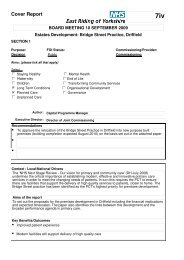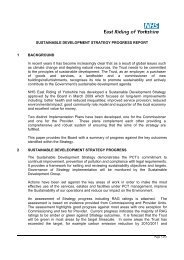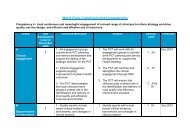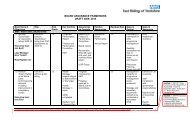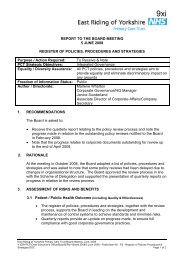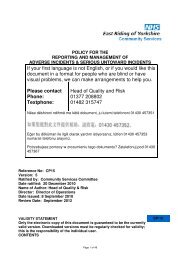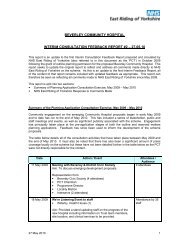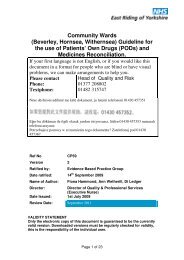Guidelines for the Management of Haematological Malignancies
Guidelines for the Management of Haematological Malignancies
Guidelines for the Management of Haematological Malignancies
Create successful ePaper yourself
Turn your PDF publications into a flip-book with our unique Google optimized e-Paper software.
Notes:<br />
1. The immunophenotypic investigation <strong>of</strong> T-cell lymphoma is being reviewed and a new protocol<br />
is likely.<br />
2. Clonality studies in <strong>the</strong> absence <strong>of</strong> <strong>the</strong> morphological immunophentypic and clinical features<br />
are <strong>of</strong> no value in making a diagnosis <strong>of</strong> T-cell lymphoma and are potentially misleading<br />
because <strong>of</strong> false positives.<br />
3. In granulomatous slack skin disease, diffuse granulomata and lymphocytic infiltrate are seen<br />
in <strong>the</strong> dermis. Macrophage mediated destruction <strong>of</strong> elastic tissue occurs which leads to <strong>the</strong><br />
development <strong>of</strong> pendulous folds <strong>of</strong> slack skin.<br />
Mycosis Fungoides<br />
Diagnosis requires:<br />
1. The development <strong>of</strong> tumour nodules in <strong>the</strong> clinical background <strong>of</strong> established mycosis<br />
fungoides<br />
2. A cohesive population <strong>of</strong> large lymphoid cells within <strong>the</strong> tumour; in some cases CD30+<br />
3. Cell cycle fraction in this population greater than 30%<br />
4. Abnormal P53 expression.<br />
Lymph Node Involvement<br />
Involved lymph nodes in MF/Sezary show a range <strong>of</strong> changes histologically. Some units use a grading<br />
system (category I to III after Clendenning and Rappaport) and in o<strong>the</strong>rs molecular methods are being<br />
evaluated. We recommend however that this system be adopted.<br />
1. Dermatopathic reaction only: which may include scattered atypical lymphocytes or even small<br />
clusters.<br />
2. Focal or diffuse nodal replacement by tumour cells.<br />
Sezary Syndrome<br />
Sezary syndrome is characterized by erythroderma, lymphadenopathy, splenomegaly and leukaemia<br />
(Greenberg, Cox et al. 1997; Wood and Greenberg 2003)<br />
The diagnosis requires:<br />
1 Generalised erythroderma<br />
2 A skin biopsy showing infiltration by atypical T-cell as described <strong>for</strong> MF although <strong>the</strong><br />
histological appearances may be difficult to interpret and obscured by secondary infection<br />
(Wood and Greenberg 2003)<br />
3 Population <strong>of</strong> circulating T-cell with <strong>the</strong> phenotype CD4+,CD7- by flow cytometry. This<br />
population must exceed 1x10 9 /l.<br />
4 T-cell clonality as above<br />
Notes:<br />
1. Patients will be classified as primary or secondary according to <strong>the</strong> presence <strong>of</strong> preceding<br />
mycosis fungoides<br />
2. Although morphologically derived “counts” <strong>of</strong> Sezary cells are widely used in definitions <strong>of</strong><br />
Sezary this test is inaccurate and poorly reproducible (Wood and Greenberg 2003)and<br />
<strong>the</strong>re<strong>for</strong>e will not be per<strong>for</strong>med.<br />
3. The detection <strong>of</strong> circulating cells with <strong>the</strong> above phenotype is not a test <strong>for</strong> common type<br />
mycosis fungoides and will not be per<strong>for</strong>med in <strong>the</strong> absence <strong>of</strong> a diagnosis <strong>of</strong> erythroderma<br />
and histological evidence <strong>of</strong> MF or lymphocytosis.<br />
4. All patients with a diagnosis <strong>of</strong> Sezary syndrome should be referred to an appropriate<br />
Haematology MDT.<br />
Staging investigations<br />
When <strong>the</strong> diagnosis <strong>of</strong> MF/Sezary is histologically verified, <strong>the</strong> following staging investigations are<br />
recommended:<br />
• FBC, ESR, differential WCC<br />
<strong>Guidelines</strong> <strong>for</strong> <strong>the</strong> <strong>Management</strong> <strong>of</strong> <strong>Haematological</strong> <strong>Malignancies</strong><br />
14. CUTANEOUS LYMPHOMA<br />
32




